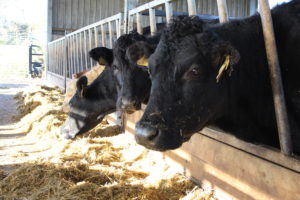TB Exemption
19 January 2018 As Scotland has been Officially Tuberculosis Free since 2009, a more flexible approach to testing was introduced in 2012 (and revised in 2017) for what are to be considered ‘lower risk’ herds. Scottish herds that meet certain criteria can be exempt from routine herd testing for TB, meaning that they do not have to carry out the whole herd test every four years.
As Scotland has been Officially Tuberculosis Free since 2009, a more flexible approach to testing was introduced in 2012 (and revised in 2017) for what are to be considered ‘lower risk’ herds. Scottish herds that meet certain criteria can be exempt from routine herd testing for TB, meaning that they do not have to carry out the whole herd test every four years.
Herds must fit into one of the following categories to be exempt from routine testing:
- Herds with less than 50 cattle which have had less than two consignments of cattle moved on from high risk TB areas in the previous four years (increased in January 2017, previously only for herds with less than 20 cattle).
- Herds that slaughter more than 25% of their stock annually and have had less than two consignments of cattle moved on from high risk TB areas in the previous four years.
- Herds that slaughter more than 40% of their stock annually.
All herds will receive a letter annually to remind them of their status or to notify them of any change. This allows you to make an informed choice on management practices that could lead to your herd being considered for exemption from routine testing.
Other facts to be aware of:
Post- movement/post-import tests for animals from high risk areas and tests required due to suspicion of disease will still take place, regardless of a herd’s exempt status.
Herds on annual testing are not considered for exemption.
High risk TB areas include annual testing areas of England and Wales, Northern Ireland and Republic of Ireland.
The reason that herds with a higher proportion of animals going for slaughter are considered for exemption is the fact that this means that a high proportion of the herd is checked for TB lesions during Post Mortem examination.
Herds which appear to be only at ‘low risk’ of contracting TB could still potentially spread disease if they were infected and selling the majority of stock as stores or calves, therefore they are tested. Herds which are small are less likely to become infected and are therefore exempt.
Slaughtered animals refers to animals that have been on the holding for at least 60 days that move either direct from farm to slaughterhouse, or direct from farm to market and then direct to slaughterhouse. Animals moving onto another holding temporarily between market and slaughterhouse are not included. The slaughter rate is calculated on the total number of cattle slaughtered in a slaughterhouse in the previous calendar year divided by the herd size (total stock on farm on 1 January).
For further information visit: www.gov.scot/Topics/farmingrural/Agriculture/animal-welfare/Diseases/disease/tuberculosis
John Schofield, SAC Consulting Veterinary Services
Sign up to the FAS newsletter
Receive updates on news, events and publications from Scotland’s Farm Advisory Service
